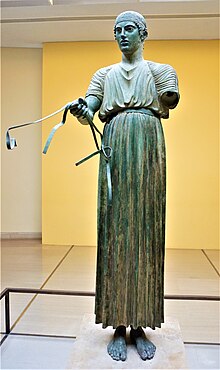This article needs additional citations for verification. (February 2019) |

Clothing in ancient Greece refers to clothing starting from the Aegean bronze age (3000 BCE) to the Hellenistic period (31 BCE).[1] Clothing in ancient Greece included a wide variety of styles but primarily consisted of the chiton, peplos, himation, and chlamys.[2] Ancient Greek civilians typically wore two pieces of clothing draped about the body: an undergarment (χιτών : chitōn or πέπλος : péplos) and a cloak (ἱμάτιον : himátion or χλαμύς : chlamýs).[3] The people of ancient Greece had many factors (political, economic, social, and cultural) that determined what they wore and when they wore it.[2]
Clothes were quite simple, draped, loose-fitting and free-flowing.[4] Customarily, clothing was homemade and cut to various lengths of rectangular linen or wool fabric with minimal cutting or sewing, and secured with ornamental clasps or pins, and a belt, or girdle (ζώνη: zōnē).[4][page needed] Pieces were generally interchangeable between men and women.[5] However, women usually wore their robes to their ankles while men generally wore theirs to their knees depending on the occasion and circumstance.[4] Additionally, clothing often served many purposes than just being used as clothes such as bedding or a shroud.[6]
In ancient Greece the terms ἀκεστής (male) and ἀκέστρια (female) were used for people who patched and restored clothing.[7]
The shoemakers had two kind of knives for cutting leather, the σμίλη or σμιλίον, which has a straight blade and the τομεὺς or περιτομεύς, which had a crescent shaped blade.[8]
- ^ Condra, Jill (2008). The Greenwood Encyclopedia of Clothing Through World History, Vol. 1. Greenwood Press. ISBN 978-0-313-33662-1.
- ^ a b Nigro, Jeff (1 February 2022). "Ancient Greek Dress: The Classic Look". Art Institute of Chicago.
- ^ Alden, Maureen (January 2003), "Ancient Greek Dress", Costume, 37 (1): 1–16, doi:10.1179/cos.2003.37.1.1
- ^ a b c Lee, Mireille M. (2015). Body, dress, and identity in ancient Greece. New York: Cambridge University Press. ISBN 978-1-107-05536-0.
- ^ Adkins, Lesley, and Roy Adkins. Handbook to Life in Ancient Greece. New York: Facts On File, 1997. Print.
- ^ "Ancient Greek Dress". The Metropolitan Museum of Art. Retrieved 20 May 2023.
- ^ Harry Thurston Peck, Harpers Dictionary of Classical Antiquities (1898), Sartor
- ^ A Dictionary of Greek and Roman Antiquities (1890), Scalprum